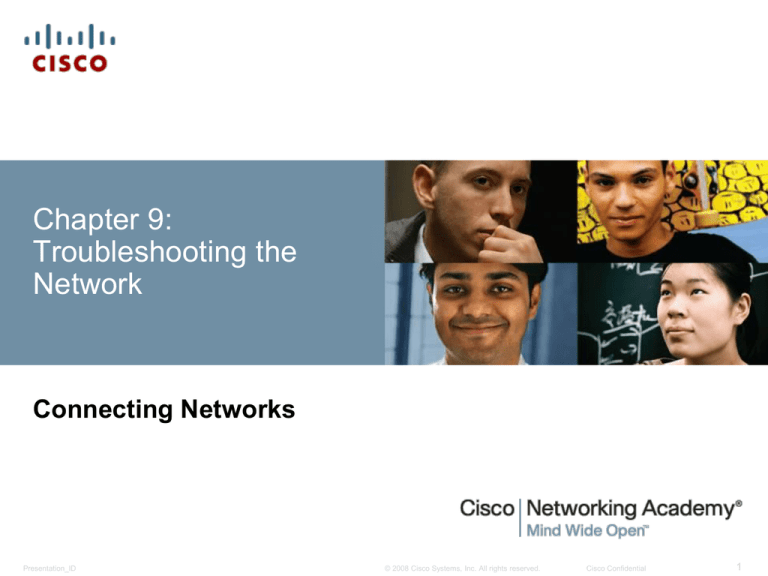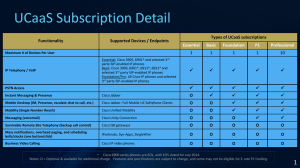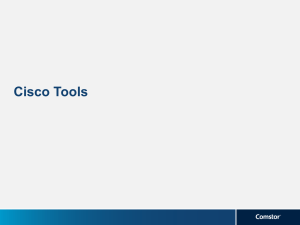
Chapter 9:
Troubleshooting the
Network
Connecting Networks
Presentation_ID
© 2008 Cisco Systems, Inc. All rights reserved.
Cisco Confidential
1
Chapter 9
9.0 Introduction
9.1 Troubleshooting with a Systematic Approach
9.2 Network Troubleshooting
9.3 Summary
Presentation_ID
© 2008 Cisco Systems, Inc. All rights reserved.
Cisco Confidential
2
9.1 Troubleshooting with a
Systematic Approach
Presentation_ID
© 2008 Cisco Systems, Inc. All rights reserved.
Cisco Confidential
3
Chapter 9: Objectives
Explain how network documentation is developed and used to
troubleshoot network issues.
Describe the general troubleshooting process.
Compare troubleshooting methods that use a systematic, layered
approach.
Describe troubleshooting tools used to gather and analyze
symptoms of network problems.
Determine the symptoms and causes of network problems using a
layered model.
Troubleshoot a network using the layered model.
Presentation_ID
© 2008 Cisco Systems, Inc. All rights reserved.
Cisco Confidential
4
Network Documentation
Documenting the Network
Network documentation is a complete set of accurate and current
network documentation. This documentation includes:
Configuration files, including network configuration files and endsystem configuration files
Physical and logical topology diagrams
A baseline performance level
Presentation_ID
© 2008 Cisco Systems, Inc. All rights reserved.
Cisco Confidential
5
Network Documentation
Network Topology Diagrams
Physical Topology
Logical Topology
Device type
Model and manufacturer
Device identifiers
IP address and prefix lengths
Operating system version
Cable type and identifier
Interface identifiers
Connection type
Cable specification
Connector type
DLCI for virtual circuits
Site-to-site VPNs
Cabling endpoints
Routing protocols
Static routes
Data-link protocols
WAN technologies used
Presentation_ID
© 2008 Cisco Systems, Inc. All rights reserved.
Cisco Confidential
6
Network Documentation
Establishing a Network Baseline
Presentation_ID
© 2008 Cisco Systems, Inc. All rights reserved.
Cisco Confidential
7
Network Documentation
Establishing a Network Baseline (cont.)
Step 1. Determine
what types of data
to collect.
Step 2. Identify
devices and ports
of interest.
Step 3. Determine
the baseline
duration.
Presentation_ID
© 2008 Cisco Systems, Inc. All rights reserved.
Cisco Confidential
8
Network Documentation
Measuring Data
Commands that are useful to the network documentation process
include:
ping
telnet
show ip interface brief
show ipv6 interface brief
show ip route
show ipv6 route
show cdp neighbor detail
Presentation_ID
© 2008 Cisco Systems, Inc. All rights reserved.
Cisco Confidential
9
Troubleshooting Process
General Troubleshooting Procedures
Presentation_ID
© 2008 Cisco Systems, Inc. All rights reserved.
Cisco Confidential
10
Troubleshooting Process
Gathering Symptoms
Presentation_ID
© 2008 Cisco Systems, Inc. All rights reserved.
Cisco Confidential
11
Troubleshooting Process
Questioning End Users
Presentation_ID
© 2008 Cisco Systems, Inc. All rights reserved.
Cisco Confidential
12
Isolating the Issue Using Layered Models
Using Layered Models for Troubleshooting
Presentation_ID
© 2008 Cisco Systems, Inc. All rights reserved.
Cisco Confidential
13
Isolating the Issue Using Layered Models
Troubleshooting Methods
Using the layered models, there are three primary methods for
troubleshooting networks:
Bottom-up
Top-down
Divide-and-conquer
Presentation_ID
© 2008 Cisco Systems, Inc. All rights reserved.
Cisco Confidential
14
Isolating the Issue Using Layered Models
Troubleshooting Methods (cont.)
In addition to the systematic, layered approach to troubleshooting,
there are also, less-structured troubleshooting approaches:
One troubleshooting approach is based on an educated guess by
the network administrator, based on the symptoms of the problem.
Another approach involves comparing a working and nonworking
situation, and spotting significant differences.
Swapping the problematic device with a known, working one is a
quick way to troubleshoot.
Presentation_ID
© 2008 Cisco Systems, Inc. All rights reserved.
Cisco Confidential
15
Isolating the Issue Using Layered Models
Guidelines for Selecting a Troubleshooting Method
Presentation_ID
© 2008 Cisco Systems, Inc. All rights reserved.
Cisco Confidential
16
9.2 Network Troubleshooting
Presentation_ID
© 2008 Cisco Systems, Inc. All rights reserved.
Cisco Confidential
17
Troubleshooting Tools
Software Troubleshooting Tools
Common software troubleshooting tools include:
NMS tools
Knowledge bases
Baselining tools
Host-based protocol analyzers
Cisco IOS EPC
Presentation_ID
© 2008 Cisco Systems, Inc. All rights reserved.
Cisco Confidential
18
Troubleshooting Tools
Hardware Troubleshooting Tools
Common hardware troubleshooting tools include:
Network analysis module
Digital multimeters
Cable testers
Cable analyzers
Portable network analyzers
Presentation_ID
© 2008 Cisco Systems, Inc. All rights reserved.
Cisco Confidential
19
Troubleshooting Tools
Using a Syslog Server for Troubleshooting
Severity Level
Presentation_ID
© 2008 Cisco Systems, Inc. All rights reserved.
Cisco Confidential
20
Symptoms and Causes of Network Troubleshooting
Physical Layer Troubleshooting
Presentation_ID
© 2008 Cisco Systems, Inc. All rights reserved.
Cisco Confidential
21
Symptoms and Causes of Network Troubleshooting
Data Link Layer Troubleshooting
Presentation_ID
© 2008 Cisco Systems, Inc. All rights reserved.
Cisco Confidential
22
Symptoms and Causes of Network Troubleshooting
Network Layer Troubleshooting
Presentation_ID
© 2008 Cisco Systems, Inc. All rights reserved.
Cisco Confidential
23
Symptoms and Causes of Network Troubleshooting
Transport Layer Troubleshooting – ACLs
Presentation_ID
© 2008 Cisco Systems, Inc. All rights reserved.
Cisco Confidential
24
Symptoms and Causes of Network Troubleshooting
Transport Layer Troubleshooting – NAT for IPv4
Presentation_ID
© 2008 Cisco Systems, Inc. All rights reserved.
Cisco Confidential
25
Symptoms and Causes of Network Troubleshooting
Application Layer Troubleshooting
Presentation_ID
© 2008 Cisco Systems, Inc. All rights reserved.
Cisco Confidential
26
Troubleshooting IP Connectivity
Components of Troubleshooting End-to-End Connectivity
When there is no end-to-end connectivity, and the administrator
chooses to troubleshoot with a bottom-up approach, these are
common steps the administrator can take:
Step 1. Check physical connectivity at the point where network
communication stops, including cables and hardware. The
problem might be with a faulty cable or interface, or involve
misconfigured or faulty hardware.
Step 2. Check for duplex mismatches.
Step 3. Check data link and network layer addressing on the local
network. This includes IPv4 ARP tables, IPv6 neighbor
tables, MAC address tables, and VLAN assignments.
Presentation_ID
© 2008 Cisco Systems, Inc. All rights reserved.
Cisco Confidential
27
Troubleshooting IP Connectivity
Components of Troubleshooting End-to-End Connectivity (cont.)
Step 4. Verify that the default gateway is correct.
Step 5. Ensure that devices are determining the correct path from
the source to the destination. Manipulate the routing
information if necessary.
Step 6. Verify that the transport layer is functioning properly. Telnet
can also be used to test transport layer connections from the
command line.
Step 7. Verify that there are no ACLs blocking traffic.
Step 8. Ensure that DNS settings are correct. There should be an
accessible DNS server.
Presentation_ID
© 2008 Cisco Systems, Inc. All rights reserved.
Cisco Confidential
28
Troubleshooting IP Connectivity
End-to-End Connectivity Problem Initiates Troubleshooting
Presentation_ID
© 2008 Cisco Systems, Inc. All rights reserved.
Cisco Confidential
29
Troubleshooting IP Connectivity
Step 1. Verify the Physical Layer
Presentation_ID
© 2008 Cisco Systems, Inc. All rights reserved.
Cisco Confidential
30
Troubleshooting IP Connectivity
Step 2. Check for Duplex Mismatches
Presentation_ID
© 2008 Cisco Systems, Inc. All rights reserved.
Cisco Confidential
31
Troubleshooting IP Connectivity
Step 3. Verify Layer 2 and Layer 3 Addressing on the
Local Network
IPv4:
IPv6:
arp command (PC)
netsh interface ipv6
show neighbor command
(PC)
show mac addresstable command (router)
Presentation_ID
show ipv6 neighbors
(router)
© 2008 Cisco Systems, Inc. All rights reserved.
Cisco Confidential
32
Troubleshooting IP Connectivity
Step 4. Verify Default Gateway
Presentation_ID
© 2008 Cisco Systems, Inc. All rights reserved.
Cisco Confidential
33
Troubleshooting IP Connectivity
Step 5. Verify Correct Path
Presentation_ID
© 2008 Cisco Systems, Inc. All rights reserved.
Cisco Confidential
34
Troubleshooting IP Connectivity
Step 6. Verify the Transport Layer
Presentation_ID
© 2008 Cisco Systems, Inc. All rights reserved.
Cisco Confidential
35
Troubleshooting IP Connectivity
Step 7. Verify ACLs
Presentation_ID
© 2008 Cisco Systems, Inc. All rights reserved.
Cisco Confidential
36
Troubleshooting IP Connectivity
Step 8. Verify DNS
Presentation_ID
© 2008 Cisco Systems, Inc. All rights reserved.
Cisco Confidential
37
Chapter 9: Summary
Presentation_ID
© 2008 Cisco Systems, Inc. All rights reserved.
Cisco Confidential
38
Presentation_ID
© 2008 Cisco Systems, Inc. All rights reserved.
Cisco Confidential
39







